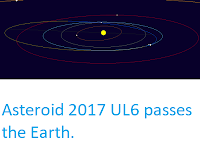Asteroid (503941) 2003 UV11 passed by the Earth at a distance of about 5 755 000
km (15.0 times the average distance between the Earth and the Moon, or 3.85% of the distance between the Earth and the Sun), slightly after 3.00 am
GMT on Tuesday 31 October 2017. There was no danger of
the asteroid hitting us, though were it to do so it would have
presented a significant threat. (503941) 2003 UV11 has an estimated
equivalent
diameter of 240-750 m (i.e. it is estimated that a spherical object
with
the same volume would be 240-750 m in diameter), and an object at the
upper end of this
size range would be predicted to be capable of
passing through the Earth's
atmosphere relatively intact, impacting the ground directly with an
explosion that would be 35 000-1 175 000 times as powerful as the
Hiroshima
bomb. Such an impact would result in an impact crater over 3.8-11 km
in
diameter
and devastation on a global scale, as well as climatic effects that
would last decades or even centuries.
Image of (503941) 2003 UV11 taken on 22 October 2017 using the iTelescope T05 MPC H06 remotely operated telescope at Mayhill Observatory in New Mexico. Image
is a composite made of seven 40 second exposures; stars appear elongated as they move across the field, the asteroid is a single
spot (indicated by the arrow) as the telescope is being trained on this
object. iTelescope/Marian Urbanic/Fotografický občasník.
(503941) 2003 UV11 was discovered on 21 October 2003 by the Lowell Observatory Near-Earth-Object Search, at Anderson Mesa Station, near Flagstaff, Arizona. The
designation 2003 UV11 implies that it was the 296th asteroid (asteroid V11)
discovered in the second half of October 2003 (period 2003 U), while
the designation 503941 implies that it was 503 941st asteroid ever
discovered (asteroids are not given this longer designation immediately
to avoid naming double or false sightings).
(503941) 2003 UV11 has a 640 day orbital period, with an elliptical orbit tilted at
an angle of 5.93° to the plain of the Solar System which takes in to
0.34 AU from the Sun (34% of the distance at which the Earth orbits the
Sun; inside the orbit of the planet Mercury) and out to 2.56 AU (256% as far away from the Sun than the Earth). This means that close
encounters between the asteroid and Earth are fairly common, with the
last thought to have happened in October 2010 and the next predicted
in November 2024. It is therefore
classed as an
Apollo Group Asteroid (an asteroid that is on average further from the
Sun than the Earth, but which does get closer). As an asteroid probably larger than 150 m in diameter
that occasionally comes within 0.05 AU of the Earth, (503941) 2003 UV11 is also
classified as a Potentially Hazardous Asteroid.
(503941) 2003 UV11 also
has frequent close encounters with the planets Mercury, which it is
thought to have last passed in September 2012, and is next predicted to
pass in December 2024, and Venus, which it last came close to in November 2010
and
is next predicted to pass in July 2024. Asteroids
which make close passes to multiple planets are considered to be in
unstable orbits, and are often eventually knocked out of these orbits by
these encounters, either being knocked onto a new, more stable orbit,
dropped into the Sun, knocked out of the Solar System or occasionally
colliding with a planet.
See also...
Follow Sciency Thoughts on
Facebook.








